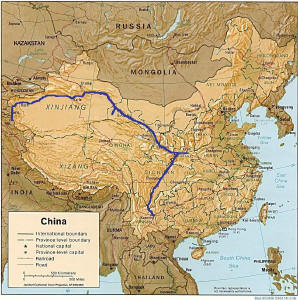 Tuesday 24 June, 2008,
Tashkurgan, Xinjiang
Tuesday 24 June, 2008,
Tashkurgan, Xinjiang
 Tuesday 24 June, 2008,
Tashkurgan, Xinjiang
Tuesday 24 June, 2008,
Tashkurgan, Xinjiang
The Chinese border post is called the Hunjrap Frontier Station. It is at the top of Khunjerab Pass (4,800m) and has magnificent scenery. The roads are definitely western standard as was the bus from Sost. Having seen other Chinese buses I imagine China imposes a certain standard on vehicles.
The luggage check at the border was quite extensive for some. There were 4 men checking, 3 were thorough, 1 much less so. Luckily I had the less thorough one. He did not even bother with my camera bag. The others went to the level of opening toothpaste tubes and smelling the contents. John has a large pack with camping gear, tent, stove, pots, pans and cutlery. His whole pack had to be opened up and checked. His day pack is almost as full with lots of camera equipment. He sneaked some photos of the process but must have been seen because every photo on his camera was looked at and the ones of the search deleted. His search took a long time. Even so his was not the most extensive. The first person in spent almost an hour having his bag searched and everything opened and checked! Even a sachet of cream was torn open a little and smelt.
The bus also had a thorough search.
The next check was at Tashkurgan. This search used modern equipment. First we had to line up our luggage and step away while it was sniffed by a dog. Then we took it into a hall. Here there was a vague manual search, then immigration, followed by putting everything through a scanner. The men had had a body search at the border but not me. This happened in Tashkurgan where there were 2 women officers. After all this we were free to go. Except that while the 5 Europeans were deciding how to get to the hotel various officers came out separately to check some detail on someone's passport. Eventually a free bus service to the Traffic Hotel in town came and we all climbed on board.
NB. I read the service promise at the border. It promised to take a maximum of 45 seconds through the border. I have a photo of the sign to prove it! Yeah well no fine!
The Uighurs are a Muslim group and
they are not very happy, they certainly don't smile often. If you need help it is
better to ask a Chinese person. Most Uighur women wear knee length skirts with
leggings to the ankles and socks. The head is covered with a hat like the men
use in Pakistan and a scarf. It looks very strange. They are allowed to
have more than 1 child as the Han Chinese now represent more than 50% of the
population in the province. The Chinese government has encouraged this migration. Apparently the Uighurs are educated in their own language although Mandarin is also a subject
at school. Their language is similar to other central Asian languages but
written in Arabic script. According the the LP it used to be written in Roman
script but this gave the population an advantage when learning English, so the
script was changed by the government. A traveller also mentioned that the
Uighurs are not allowed to be taught English either. No wonder they are unhappy.
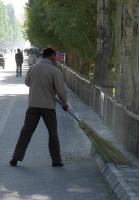

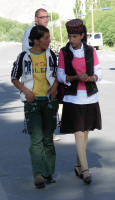
John and I went to a restaurant for dinner and decided what to have by walking around, looking at what other people were eating and asking for that. It turned out to be very spicy fish dish and a bitter vegetable dish. Oh well, so be it. John does not like spicy food so he soon learnt to say "no spice' in Chinese. Complimentary green tea is always served and the pot is kept full.
Wednesday 25 to Friday 27 June 2008, Kashgar, Xinjiang
Next morning we were woken at 6:00am local time with propaganda over all the loud speakers in town. At this rate it will take a while for me to recover from all the travelling.
We caught the local bus to Kashgar - air-conditioned, well maintained, riding on good roads. Lovely.
There were several checkpoints along the way where we all had to get out of the bus, have our passports checked and walk to the other side and wait for the bus. There was only 1 place to buy anything to eat on the 7 hour trip. The offering was cool drinks, eggs, a few peanuts and biscuits. All the shops had small solar panels to provide electricity. Another day without a proper breakfast or lunch, no wonder my weight is so low.
The scenery was magnificent though.
Mountains, snow, rivers and Lake Karakul. The Lake is a popular resort and
claims to be the most beautiful in the world. Not sure about that but it is
beautiful. People come from Kashgar for a break. They stay in a yurt and there
is trekking and camel riding available.
Eventually we left the mountains behind us and went out onto the plain following the Tashkurgan River. In the middle of nowhere there are the 5 Olympic Rings in stone set in the desert sand. Olympic fever has reached even the remote places.
A lot of work is being done to improve the productivity of the area. Plastic sheeting is placed on the ground and flood irrigation is being used. There are also green houses being constructed. Poplar trees are being planted every where as wind breaks to try and contain the desert. Like all deserts the Taklamakan Desert in the Tarim Basin is growing.
Kashgar is a lively city with an old town. We stayed 3 nights to rest up from the continuous travelling from Islamabad. We booked into the Chini Bagh the first night but the hotel was booked out from then on as there was to be a Trade Fair in a few days and the traders were arriving early to set up. Next morning we moved to a dorm at the Seman for two nights. The time was spent resting, eating the choose and point way and finding where to change money. There were lots of men asking if we wanted to change money but when I mentioned pounds they laughed and walked away. I eventually had to go to the head branch of the China Bank. Adam arrived at the Seman the same night we did. He is Chinese working as an accountant in Beijing who uses his 6 days annual leave to see China. It was great having him with us. First he taught John how to say 'no spice' then he went with us through the old town. He had already found out that the brick paving meant a dead end and the big blocks meant a through road. This way we managed to avoid the ticket office where you are expected to pay for walking through.
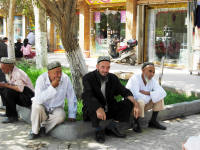
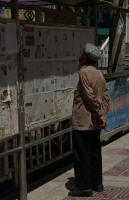
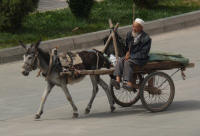
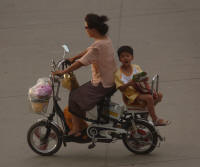
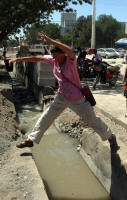
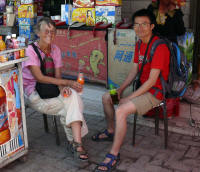
Saturday 28 June 2008, overnight train to Turpan, Xinjiang
The train was a pleasure. It left on time. When we had asked Adam if trains left on time, he had been puzzled by the question. Of course trains leave on time. Indian trains also leave on time. The difference is the cleanliness, the provision of hot water and bedding on the hard sleepers. You have hard or soft sleepers. In India the non A/c sleepers do not have bedding provided. The beds were OK, not all that hard at all. There is an attendant who checks the tickets and others who keep the train clean. There are bins for rubbish which are emptied at a station when required. The toilets are also cleaned and water added to the tanks when necessary. The toilets are locked by the attendant whenever the train stops. Different from India where the rubbish bin is the open window. When the water has gone in the toilets, that's it until the final destination, and no-one cleans up if some-one makes a mess. They are used even at the stations. The floor is swept occasionally by a young boy trying to make some money as it provides the alternative rubbish bin. The tracks are smooth in China so sleeping is much easier than the rough Indian tracks. Altogether a pleasurable experience. John and I went to breakfast in the dining car and on the way back met Adam and Nick. Nick told us that the next station Daheyan was the closest station to get off for Turpan. We had less than 10 minutes to prepare but we managed. Adam came with us in a shared taxi to Turpan, 58k away.
Sunday 29 June 2008, Turpan, Xinjiang
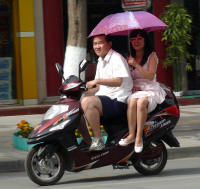 Turpan is
in the second lowest depression
in the world after the Dead Sea at 154m below sea level. It is very hot with the
highest recorded temperature at 49.6˚C.
It was an oasis on the northern silk route but now grows grapes. The grapes are
usually dried but some are made into wine.
Turpan is
in the second lowest depression
in the world after the Dead Sea at 154m below sea level. It is very hot with the
highest recorded temperature at 49.6˚C.
It was an oasis on the northern silk route but now grows grapes. The grapes are
usually dried but some are made into wine.
I needed the toilet as I had not had time on the train. My first experience of public toilets! It was a tiled trench in the floor with partitions. You choose an empty cubicle, if you can call a space with 3 sides a cubicle, and do your thing on top of the last person's turd. I assume it is flushed out once a day as there were only a few turds in the cubicle I used. The smell is unpleasant and you have to pay. No paper or water is provided for cleaning the bum nor is there a facility to wash your hands afterwards. Ugh!
Adam had intended to go to the Jiaohe ruins with us and then on to Urumqi to catch his plane back to Beijing. Unfortunately his camera was missing. He had taken a photo at the train station while we were discussing taxi prices and thinks he put it in his bag. A tour organiser took him back on his bike. I intend to write to him and find out what happened.
But first a tour organiser convinced the 3 of us to go on a tour. Sounded good at the time. It consisted of an afternoon tour followed by a morning tour to take in all the sights. In hind sight we should have caught the bus to the Jiaohe ruins and left it at that. The afternoon tour started at 4:30pm when some of the heat had died down.
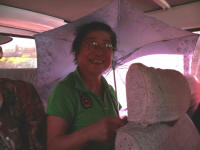
The tour consisted of the 3 of us plus
7 Chinese tourists. They were a very merry bunch and laughed a lot. The tour took us to Grape Valley first. This is a series of stops
with walks through grape arbours to the tourist shops. You could also see the
cocks used in cock fights. Not overly interesting.
In fact the most 'interesting' part was the bike accident at the second stop.
The bus had slowed down to turn left and went smack into a motor cycle. I did
not see the accident but I can only assume that the bike was travelling fast and
decided to avoid the bus by going to the right i.e. exactly where the bus was
headed. The motor cycle driver was unconscious and his girlfriend hysterical.
She wanted to turn him over and get him up. John made sure his air passages were
open and I tried to keep the girlfriend from turning him over. I even persuaded
some-one to shade his head with an umbrella. Eventually he came round and, with
assistance moved into the shade. He had a nasty bang on the head and a broken
forearm. While this was happening there was another bike accident about 100m
away. Driving too fast around a curve, the bike hit the embankment of the canal
which sent bike, driver and passenger into the canal. This lot were (according to
Nick and John) shoved into a taxi even though they were still unconscious!
Please don't let me be in an accident!
The Jiaohe ruins on the other hand were well worth the visit. The first settlement on the plateau in the Yarnaz Valley was around 200 BCE. The plateau is about 30 meters above the surrounding river. During the Han Dynasty 140BCE to 20CE Jiaohe was established as a garrison town on the Silk Route At its height from around 640 - 800 CE during the Tang Dynasty it housed 6,500 people, according to the LP making it one of the largest, oldest and best preserved ruins. But there was Bam in Iran from around 1BCE destroyed by an earthquake in 2003 and Moenjodaro in Pakistan which is better preserved and much older (1500BCE). Can't believe all you read! Even so I enjoyed looking over the ruins.
That evening the 3 of us went out for dinner and witnessed a musical fountain. There were many different varieties of water projection, circular, waving, straight up and down in a line or circle with movements all co-ordinated to the music. It was quite impressive.
The next morning we visited the Flaming Mountains. These are supposed to be very red at mid-day but at 9:00am they were pretty grey; the Gaochang ruins, a 7th century town not as well preserved as Jiaohe; Emin Minaret and the Karez museum. No-one wanted to go into the Gaochang ruins or the Emin Minaret as by this time even the Chinese tourists were tired of paying to see souvenir stalls!
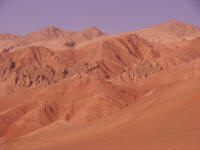
The only one I wanted to see was the Karez. While waiting to buy my ticket I read the promise of service. Among other things it said that students and people over 60 could go in for half price. Over 70 was free! Great, half price for me. Then the discussion began. I had to be a Chinese citizen. One of the Chinese students helped me to point out that the sign said I could go in for half price. After a phone call to some-one I was allowed in for half price. Once again there were many souvenir stalls plus a representation of the Karez system with models of people digging the canals and using the water. This system is also used in Iran and Central Asia. A well is dug high up in the mountains (the Bogda Mountains in Turpan). A channel is then dug underground with a well every 20 meters to aid construction and provide access. The well is usually fed by snow melt and gravity takes it down to the town. The system provides water and prevents evaporation in dry, hot climates. The Turpan system was built over 2,000 years ago with primitive equipment and has 5,000km of channels. Today it provides 30% of Turpan's water requirements. Quite incredible.
After the tour we fetched our luggage and caught the bus to Urumqi, 182k away. Nick was flying out the next evening. John and I decided to buy the train tickets first before going to a hotel. The queue was very long but moved reasonably quickly. I managed to buy the tickets to Liuyuan, the closest station to Dunhuang using the Chinese characters in the LP and the bit of English understood by the ticket officer. John waited with the luggage. I actually managed to buy tickets for that night, giving us just over an hour to have a meal and join the train. In fact the train was going to Dunhuang! Admittedly this service has only been available for a month and the LP said it was under construction. The penalty for extending our ticket was quite high, 60 Yuan each plus the additional cost of the ticket. It was worth it though as we could stay on the train until 10:00am instead of getting off at 6:00am. I could have a good sleep in.
Monday 30 June 2008, overnight train to Dunhuang, Gansu
What can be said of an overnight train
trip? We didn't see much until the morning. In the
morning we passed several wind farms and a lot of green houses. Three sides are
made of mud. the roof and last side of sticks covered in plastic. There is
rolled up matting on top of the long wall, presumably to be unrolled in winter
to provide warmth.
Tuesday 1 to Wednesday 2 July 2008, Dunhuang, Gansu
Dunhuang had Olympic fever. The torch
was coming through on 5th July and preparations were already in progress. There
were a lot of army personnel arriving in town. We wanted to stay in a dorm but
there were no more dorms so we ended up in a double room with hot water at night,
only on the first night, damp carpeting outside the bathroom, a wonderful view
of the kitchen belonging to the restaurant next door, dull lights which were
virtually useless and a door lock which didn't work. The door seemed locked if
you pulled the handle down but if you pushed it up the door opened! All these
features came to light one by one. At least the room was cheap. To overcome the
lock problem I put everything into the big blue bag and locked it. We told
reception about the lock and they would certainly notice the luggage if it was
removed. The only really valuable thing left in the room was my laptop.
NB: The Olympic rings may represent the 5 continental areas but there is no consensus on which colour belongs to which continent, except blue is Oceana (major landmasses Australia, New Zealand and New Guinea). China is using the red dragon as their major mascot and I always have associated black with Africa.
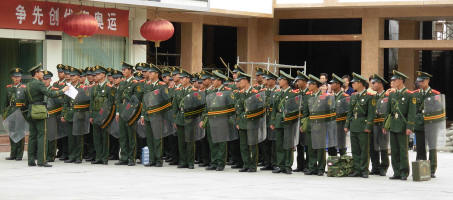
The reason for coming to Dunhuang is
to see the Mogao caves. These are a large repository of Buddhist Art. At its
peak there were 18 monasteries and over 14000 monks.
I checked the English regulations but unfortunately there was no half price for foreigners. No-one is allowed into the caves without a guide who locks the caves after you have been in unless there is another guide going in. All the caves have doors and locks. Several have air-conditioning and monitors for carbon dioxide. It this goes over the critical level everyone must leave and the cave is locked. They are trying various methods to preserve the caves such as bamboo sticks between the floor and the murals to increase air circulation and cold lights. If the lights work they will be introduced into all the caves and torches will no longer be required. Naturally photos are not allowed, not even without flash. Guess they understand the tourist mentality which will always try and sneak a photo.
The statues are made from a wood frame with mud and grass moulding. They are then painted. The colours are fantastic, even after so many years. They could do with a good vacuum though as a lot of dust has accumulated on surfaces facing up. Maybe they will come up with a way of doing this that will not destroy the statues.
The traditional date given for the founding of the first cave is 366CE. It was carved by a Buddhist monk for solitary meditation. Over the next 1,000 years additional caves were carved and richly decorated as shrines. Caravans used to make the detour to the caves to give thanks for a safe passage through the wastelands to the west. Wealthy merchants paid for new caves to be created. The world's 3rd largest Buddha, 34.5m, is in cave 96. After the collapse of trade along the silk route in the Yuan Dynasty (1206 -1368 CE) the site became deserted and forgotten until various Europeans rediscovered them in the early 20th century - and removed murals, statues and a large proportion of the manuscripts found in a hidden library.
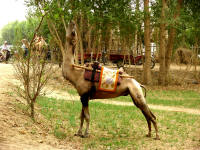
We did go out to Crescent Moon Lake which lies at the bottom of a large sand dune. The entrance fee was exorbitant though so we did not enter but unsuccessfully tried to find the back way in. It would have been hot, heavy work to climb the dune anyway and with the wind blowing up the sand I doubt we would have seen much. We contented ourselves with looking at the camels instead. There were hundreds of them all ready and waiting for a passenger. Unfortunately they were under and between trees so you could not see the full extent of the herd in one go.
Wednesday morning we had booked the 9:30am train to Jiayuguan. Unfortunately this was also the morning for a practice run for the torch going through Dunhuang. The result was we had to leave town by 7:30am. Even then the street had already been blocked off and we had to walk a few blocks to catch a taxi - no buses naturally. The taxi headed off along the normal route only to be stopped and turned back. He ended up going via many side roads and had to ask directions a number of times but we finally arrived. The waiting hall was half full of passengers who had already arrived. The whole town was closed down for the morning.
Thursday 3 July 2008, Jiayuguan, Gansu
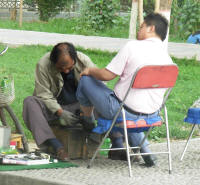 This time the hotel room had sufficient locks to ensure
that no-one could enter while any one was inside! The main lock also worked.
This time the hotel room had sufficient locks to ensure
that no-one could enter while any one was inside! The main lock also worked.
We discovered very quickly that we were out of a Muslim influenced area. We had dinner at the night market but did not ask the price first. We paid at least double. Next time I forget to ask the price I will refuse to over pay and only pay a reasonable amount. We are now in China proper where tourists are considered walking money and a target for rip offs.
One thing that has been confirmed is that the sewerage systems cannot take toilet paper. No paper or water is ever provided to clean up even in the best of toilets. At least in Pakistan and India water is provided. But in China young children are not taught to clean their bum afterwards. They do their thing, in public, anywhere, and then continue. I will have to ensure I always have some paper in my pocket and some drinking water. The water is also not drinkable. It is always served after boiling, usually as green tea but sometimes just hot water.
The Hexi corridor runs from somewhere near Dunhuang in the west to Jiayuguan in the east dividing the western wilderness from Imperial China. It is an area between two mountain ranges Today it is basically the province of Gansu. We could see the southern mountains (Quilian Shan mountains) from the train, but no mountains or even hills to the north.
Farming had been introduced in the Hexi corridor during the Qin dynasty (circa 200 BCE). To start with the soldiers had part time farming duties, but eventually immigrants were encouraged to settle and farm. The food was used to supply the garrison and the local community. Between the Han and Tang dynasties (140 BCE to circa 700 CE) the Hexi Corridor produced large quantities of silk to try and satisfy the high demand.
The Jiayuguan Fort is at the end of the Great Wall but was only built during the Ming dynasty in 1372. Beyond this to the west only a few garrison towns were built. Imperial China considered this the end of civilisation. The wall itself was started in the 7th century BCE at the city of Chu, somewhere in central China. It is not a single wall but a series of walls that are not connected. To the north there are several walls more or less parallel to each other. In all there is 25,000 kilometres of wall built over 2,000 years.
The fort has two gates. The eastern gate is called the Gate of Enlightenment and the western gate the Gate of Conciliations. Presumably when you went east you went towards enlightenment. Exiles were sent west. Each gate is a double gate to trap invaders. It was interesting to visit. We met two American backpackers our age in town who came out with us. It is always so nice to meet people around my age. We had some interesting discussions on the state of America. Needless to say they were anti-Bush like all the older Americans I have met on my travels.
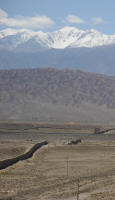
Friday 4 July 2008, overnight bus to Lanzhou, Gansu.
We decided to go to Lanzhou by sleeper bus as we wanted to go to Xiahe near the Tibetan border and had been told it was again open to foreigners. The bus seemed the most convenient. The beds are short and narrow with 3 across and 2 aisles. They were too short and narrow for the Chinese who tend to be smaller. There were knees sticking out into the aisle everywhere. A typical westerner would have a hard time scrunching up into the space provided. A hard pillow and duvet were provided. The bus left on time at 6:30pm but took almost two hours to leave the city limits. The first toilet break was about 5:00am! And then it was a spot at the side of the road. Indian and Pakistani modesty does not apply in China!
Saturday 5 July 2008, Lanzhou, Gansu
We arrived about half an hour late and headed straight to the South Bus Station. When I asked for tickets to Xiahe I was told 'no buses' in a very curt manner by two different people. Eventually some English speaking Chinese tried to help and said they could buy the tickets for us. Neither John nor I wanted to risk going somewhere we were not wanted by the government though and decided to give it a miss. We had to return to the main train station to buy our onward tickets to Xian which were for the next day. We were assisted by a young Chinese girl who insisted on coming with us, except the LP knew more about which buses to take than she did. We went around in circles but eventually arrived at the station. Here she was a great help in buying the train tickets. Then it was a matter of finding a hotel as the train left the next morning. I spent the afternoon sleeping. I really need some time out. We have been moving quite fast since Islamabad and I need quite a few days to recover before I go on. Definitely in Xian! John will be heading for Beijing to obtain his Mongolian visa and I will be meeting up with Pieter.
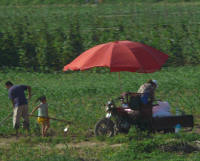
Sunday 6 to Friday 18 July 2008, Xian, Shaanxi
The train journey was interesting. The hills went from dry to a blush of green, then small shrubs, then trees. Obviously we are entering into a more lush part of China. We had bought sleeper tickets as we were not sure how long the journey would take. It took less than 8 hours so a seat would have been fine. Except we could see the people lined up to get into the seat carriages. They would have been crowded! It was much nicer to have a 6 person compartment to ourselves.
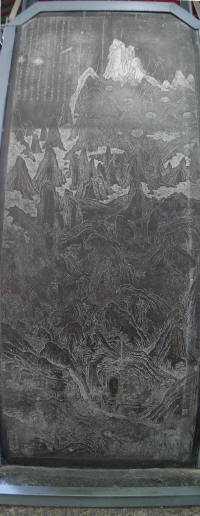
Monday was spent relaxing, orientating ourselves, seeing
the Great Mosque and the Forest of Stelae museum. The Mosque
is really a Chinese building with some Arabic script. The call to prayer is in
Chinese, it sounded very strange after the other Muslim countries. It was also
strange to see Han Chinese entering and leaving the mosque. I just don't
associate Han Chinese with religion. The Forest of Stelae museum is in an old
Confucian Temple from 1087 CE. It is surrounded
by calligraphy businesses. The over 1,000 stone stelae in the museum are considered the
epitome of Chinese calligraphy. Since I can't read Chinese other things
interested me more such as the horse hitching posts, the tomb doors and the
stone tortoise with an inscription on its back. There were also Buddha statues
in the Ghandara style from 600-700 CE. The Ghandara style was developed in
Taxila near Islamabad.
Next morning Pieter arrived after
sitting up all night on the train. It was impossible to see him amongst the
crowd. Thanks to cell phones we ended up meeting near the busses. He was very
tired and needed to sleep, so after settling him into the hostel John and I went
out to the Army of Terracotta Warriors.
This is a subterranean life size army guarding the soul of Emperor Qin Shi Huang, or allowing him to continue his rule in the after life. His actual tomb has not yet been excavated. He unified China in 221 BCE and campaigned from Korea in the north to Vietnam in the south. He started linking city walls to create the great wall (NB: In Jaiyuguan the museum implies the wall was started much earlier). He also introduced a uniform currency, a standardised script and developed infrastructure through roads and canals.
His army is impressive. I have seen documentaries which give close up views of the statues, but reality is different. A documentary just does not give the immense scale of the army. The Chinese have done a great job at preserving what is there as well. It was discovered in 1974, just over 30 years ago. During that time the pits have been covered with gigantic roofs allowing visitors to see the extent of the army and archaeologists to continue the excavations relatively undisturbed. The construction of the army involved digging corridors deep in the ground, lining up the fired and painted warriors in the corridors, placing wooden poles on top using the walls between the corridors, covering the poles with matting and finally burying the lot. Unfortunately the army was discovered early on and many of the models destroyed. The archaeologists have put many of them together again, but to put them all together will be impossible. Unfortunately the paint is destroyed fairly quickly on exposure to light so the warriors are all monochrome with some faint colour here and there. The detail in the warriors is amazing with every one I saw having different features and details. Chrome plating was used on the metal weapons to prevent corrosion. The technique was rediscovered by the Germans in 1937 and the Americans in 1950. So much for the superiority of modern man! It will be very interesting to see what is uncovered when they start on the actual tomb.
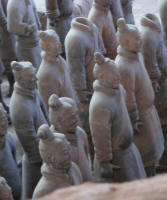
The next many days were spent doing very little, mainly washing and thinking about updating the website. John left Thursday night for Beijing and Pieter left Friday morning for Hong Kong. Alone again!
I did do some sightseeing.
Banpo Matriarch Neolithic village
dates from 4500 - 3750 BCE and was discovered in 1953. Like the Terracotta
Warriors it is covered and beautifully displayed. There is very little left of
the actual village. It takes an archaeologist to find these things.
However the presentation includes information boards in English and Chinese,
short videos on PCs, a short film and models. The houses were constructed of
wattle and daub i.e. a wooden frame with a covering of mud and straw. Apparently
they then heated the inside to bake the covering. The first houses were square,
about 4-6 meters square and the floor dug a few meters into the ground.
Later houses were round and at ground level. Some people were buried with
ceremony, others just discarded. Wonder what they did wrong? There are potsherds
with signs, an embryonic written Chinese language. It also looks like other
embryonic languages, the only difference is that it is in China. The one piece
of information missing is why it is called a matriarchal society.
Han Shua mountain is one of Taoism's 5 sacred mountains. The scenery that I could see was fantastic, granite domes with pine trees clinging to the side in a small amount of earth. The weather report predicted rain and it did, at least in the beginning. The weather only cleared when we were on our way back, before then it was very misty. I decided to do a tour as the cost of going it alone was actually higher. The tour was all Chinese tourists except for myself and an American with his Chinese female companion. I was 'adopted' by a Chinese woman who had some English. The bus dropped us off at the shuttle bus area. The shuttle bus follows a ravine to the bottom cable car station. The intrepid can walk up. We managed to see the North Peak and the West Peak (at 2086 meters above sea level it is the third highest of the 5 peaks of Mt Hua) in the allotted time, 5 hours! My legs could not have stood more anyway. The tour price included the cable car to the top, then it was a matter of walking up steps and down steps with the occasional respite of flat areas and the occasional very steep stairs. The only way from North Peak, where the cable car station is, to the other peaks is via Green Dragon Ridge which is a narrow ridge with sheer cliffs on either side - and hand rails. The Chinese love having their photo taken in front of every scenic spot. Each one separately and then as a group! I took many photos for my companion. She did tell me her name but I did not write it down and it was very Chinese. There were quite a few temples and locks with names on them which are attached to the railing rings, very often with a red ribbon as well, to bring luck to the family. Quite superstitious for a communist!
It was an exhausting day and a day of rest afterwards was a necessity. But well worth the effort. My only gripe was being asked to be ready by 7:00am and only being picked up at 8:15 am. I hate missing out on my morning sleep! I slept in the bus though, anyway the mist prevented me from seeing any scenery. On the way back we could actually see the mountains from the road.
Taoism condensed, if you are interested in more read 'The Book of the Way' written by Laotzu around 500BCE. It started purely as a philosophy like Confucianism. The Tao, or Way, is the essence of all things in the universe but ultimately cannot be defined. People must live in harmony with the universe without forcing things to their will. Religious Taoism (as opposed to philosophical Taoism) has borrowed concepts from Buddhism and folk religion and is concerned with the afterlife. Hence the temples.
The hostel put on a Chinese Shadow Show every few nights.
This is a dramatic form that originated in China about 2,000 years ago. The puppets are
made of donkey skin which has been treated to make it translucent, then coated in tung oil and dried. The parts of the puppet are cut out e.g. arms, legs, torso,
head and props. The parts are sewn together and painted. They are worked with
sticks from behind and accompanied with music and singing. Backlight casts the
figures on the screen.
I went to see the Big Wild Goose Pagoda (652 CE) but was too late to enter. It was also too early for the fountain and light show. This is reputedly the biggest in Asia but there is only a small pool. Perhaps there are water spouts that come out of the concrete area. In any case I was not prepared to wait the 3 hours. I did wander around though, people watching. There are theme parks around the Pagoda and a typical fair ground with shooting and ball throwing etc for various prizes of soft toys. And the Chinese were there in their hundreds, taking photos of themselves.
The Tang Dancing was wonderful. It is reputed to be the authentic dances and costumes from the Tang Dynasty (618-907 CE). Unfortunately it started more than half an hour early. It is really a dinner and show but I did not want the dinner, far too much food! I assume they finished serving early and did not wait for those who were only coming for the show. I saw about two thirds of the show. The dancers had magnificent clothes. The women tended to dance by walking around, swaying and waving their arms. The dances were based on poems with themes such as moonlight on water. Sounds limited but it looked great. The men had more jumping around and acrobatics in their dance routines which had war themes. There were also acrobats doing amazing things and musicians playing Tang Dynasty instruments. One of the best were a troupe of 6 women who used a string between two sticks to control a timer shaped "ball" i.e. two cones joined at the points. They would throw the "ball" in the air using the string and then catch it when it came down. In the meantime one of them managed 3 somersaults! Another juggled 5 "balls" at a time then threw 4 of them to other members of the troupe to catch. At the end there was the photo opportunity with the dancers. Only 2 Chinese men took up the offer.
I
decided to visit the tomb of Emperor Han Jing. The hostel told me to catch bus
4. Easy! Unfortunately the driver said he did not go to the tomb. Now what! I
was a fair distance from the hostel but there was a police station nearby, so I
asked them. They had a different bus number which went from the train station.
So they said they would take me there in a police car. It was the wrong bus
number. They were given another number to be caught at a different place. After
driving around town eventually it came back to bus number 4! They waited until
the bus arrived and made sure I was OK. Really very nice of them. The difference
with this bus 4 was that there was a conductor! No conductor and it does not go
to the tomb.
Emperor Han Jing ruled from 188-141 BCE, after Emperor Qin Shi Huag of the Terracotta Army. His rule was based on the Taoist concept of non interference. He used diplomacy and marriage instead of war to ensure peace. He also reduced taxes which no doubt pleased his subjects. His tomb does have a terracotta army (not life size) but there are also many domestic animals and tools. It took 28 years to build.
There are 2 museums, one near the entrance containing artefacts found in the pits and the other under the mound where the actual tomb is. This shows some of the actual pits. The large pits away from the mound have been covered over and gardens planted on top. The first museum has tiny seals that require a magnifying glass to see the detail; measures for weight and volume; models of wells and stoves; pots of copper, glazed and unglazed pottery, bronze and iron; and figures from the army. The army consisted of men, women and eunuch soldiers with women cavalry. The women cavalry all had very high prominent cheeks and very slanted eyes. The figures were moulded then legs and genitals carved. Emphasis was placed on the carving of the faces. Wooden arms were added and all painted pink. They were then dressed in silk linen or armour plate. Many of the animals removed from the pits are displayed. These cover the gamut of domesticated animals.
The underground museum has glass floors over the pits. It requires faith in the strength of the glass and courage to step on that floor! A wee bit scary. This museum is the site of ongoing work. There must be French archaeologists involved as the captions were in Chinese, English and French. A film gave a potted history of the emperor's life. The commentator also said that the eunuchs were specifically being studied to try and better understand the eunuch system in China.
The South Gate to the tomb has a covering on it to preserve what remains. The eaves had round stone ends with various inscriptions such as everlasting, timelessness and eternal happiness. The ground underneath was covered with small stones to deflect rain water and allow it to seep into the ground.
While in Xian John took many photos of people going about their business. I added some of my own. Between them you can see a microcosm that is China. Most young children who are not yet toilet trained have a split in their pants. It looks strange but anything solid either goes onto a garden or is picked up and placed in a refuse bin. Just imagine if all these children had disposable nappies! The disposal of them would be an enormous problem. This is a much better way for a large population.
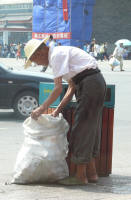
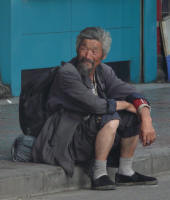
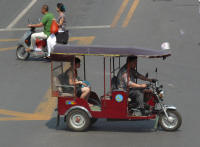
Saturday 19 to Sunday 20 July 2008, over night on train, from Shaanxi, through Sichuan to Yunan Province
Unfortunately the train to Kunming was full and I could only get hard seats. These were not quite as bad as I expected. I discovered about 5 ways of sitting where a different section of my bum was on the chair. When one section got to the impossible to endure stage, I moved position. This usually happened after I had been asleep for a few hours. I woke up to a very painful bum.
Naturally
the carriage was crowded with all the standing only passengers filling the
aisles and every other available space. I actually thought there was no wash
basin to start with because some-one had decided it made a good storage area.
The attendant must have objected because the very full hessian bags were moved.
Cleanliness is lower than in the sleepers, the sheer number of people ensured
this. The standing passengers also tried to take part of the seats as well but
the 5 Chinese I was sitting with effectively prevented this. They either kept
moving over until the intruder was forced to stand up or they told them to go.
The standing passengers often had small stools they used for sitting on but
every time a food trolley came through they had to stand up. The floor was
mopped once. A useless exercise as people walked on it before it was dry,
spreading mud. I guess any sticky stuff was removed though. The attendant also
came around frequently with a large black plastic bag to collect rubbish. Bags
of it were removed at each station. I was amazed at just how much food my 5
companions brought along. Lots of instant noodles, thick bread, hot chilli
spread for the bread, small polony, tins of food and boiled eggs. They actually
ate most of it. I felt sorry for two tribal people though. They had no stools
and I did not see then eat once, nor were they offered any leftovers. By their
clothes they seemed dirt poor. I also witnessed babies being held over the waste
bin to capture their bodily refuse. Better than the floor! I've seen that happen
once on a bus in China, only urine though, nothing solid, and Grandpa had a
large wet patch on his pants. Guess that's how you know the baby needs to go!
My 5 companions included a young man and his girlfriend. I asked for a sleeper as soon as I got on, then again at Chengdu, all without success. It seems that as soon as one set of passengers alighted another set came on. This young man was very determined to get a sleeper for himself and his girl friend though. He must have stood next to the attendant for a few hours and nagged. Eventually at 11:30pm on the second night he woke me up (yes I did manage some sleep) to tell me I had a sleeper! He had bought 3 sleepers from a station about 3 hours away. He knew I would gladly pay up. Happiness is!!!! The 3 of us went straight through to the sleeper compartment to sit and wait in the hall. I decided to lie on the floor while I waited. The attendant gave a bit of a filthy look but did not tell me to move. There were about 7 of us waiting in the corridor like a bunch of vultures. As soon as the occupants left the train at about 2:30am we all dived into the allotted beds. I must have been asleep within seconds. Clean sheets? Who cared? The train was late and only arrived in Kunming at mid-day. Almost 10 hours lying down, what a pleasure. The swelling in my ankles went almost back to normal and the excess water was eliminated. It meant I arrived reasonably alert.
The first day the scenery was clouded in mist and rain so I did not see very much. The second day I was enjoying my sleep and lie down, though what I did see looked magnificent. Green, green hills and terraced farming.